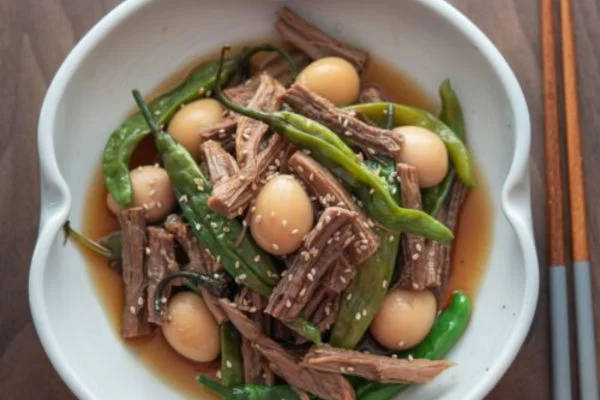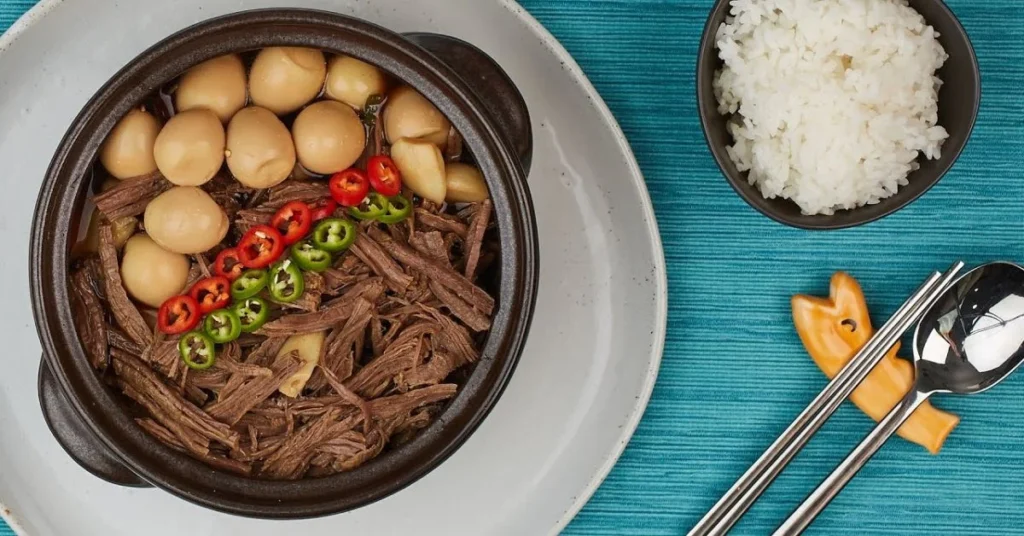JANGJORIM (SOY SAUCE BEEF AND QUAIL EGGS)
Jangjorim, a beloved Korean dish, showcases the harmonious marriage of tender beef strips and delicate quail eggs in a rich soy sauce-based broth. The beef, often cut into thin slices, undergoes a slow simmering process in a flavorful broth infused with soy sauce, brown sugar, onions, and garlic. As the beef cooks, it absorbs the savory essence of the broth, resulting in melt-in-your-mouth tenderness and a depth of flavor that’s hard to resist. Quail eggs, boiled to perfection, join the pot midway through, soaking up the delicious flavors and adding a delightful textural contrast. Jangjorim is not only a culinary delight but also a testament to the artistry and complexity of Korean cuisine, offering a symphony of flavors and textures that delight the senses with each bite.

What is Jangjorim?
Jangjorim is a traditional Korean dish simulating beef and quail eggs in a flavorful soy sauce-based broth.Jangjorim typically serves as a banchan, a small side dish accompanying the main meal in Korean cuisine. Known for its salty and slightly sweet taste, it is a favorite among many Koreans.
Key Elements of Jangjorim
01
Main Ingredients: The primary ingredients are beef and quail eggs, although chicken or pork can also be used. The beef is usually brisket or eye of round, which becomes tender when simmered.
02
Soy Sauce Broth: The dish features a rich broth made from soy sauce, water, sugar, garlic, and sometimes additional seasonings like honey, onions, and chili peppers.
03
Long Shelf Life: Because of the high salt content from the soy sauce, Jangjorim can be stored longer than other dishes. It can be refrigerated for up to a week.
04
Serving Temperature: Jangjorim is often served cold or at room temperature, which enhances its flavor.
Nutritional Benefits
Jangjorim is not only tasty but also nutritious. It provides a good amount of protein from beef and the quail eggs. Quail eggs, particularly, are rich in vitamins and minerals such as iron, phosphorus, and vitamin B12.
How to Serve Jangjorim?
Jangjorim is typically served as a side dish, or banchan, in Korean meals. It pairs perfectly with:
- Steamed Rice: The salty and slightly sweet flavors of Jangjorim complement the plain taste of steamed rice.
- Other Banchan: Serve it alongside Korean dishes like kimchi, pickled radishes, and sautéed vegetables.

Jangjorim (Soy Sauce Beef and Quail Eggs) Recipe
Jangjorim is a tasty Korean dish that combines beef and quail eggs. Cooked in soy sauce, it offers a delicious salty-sweet flavor.
Ingredients
How to make Jangjorim (Soy Sauce Beef and Quail Eggs)?
01
Prepare the Beef: If the beef slices are large, cut them into smaller, bite-sized pieces. Rinse the beef under cold water to remove any excess blood.
02
Boil the Quail Eggs: Place the quail eggs in a pot of water and boil them. Let them boil for about 5-6 minutes, then remove them from the heat and transfer them to a bowl of ice water to cool. Once cooled, peel the eggs and set them aside.
03
Make the Broth: In a large pot, combine water, soy sauce, brown sugar, sliced onion, and minced garlic. Bring the mixture to a boil over medium-high heat.
04
Simmer the Beef: Add beef slices to the pot once the broth is boiling. Reduce the heat to low and let the beef simmer gently for about 1.5 to 2 hours, or until the beef is tender and the flavors have melded together. Stir occasionally.
05
Add the Quail Eggs: After the beef has simmered for about 1 hour, add the peeled quail eggs to the pot. Let them simmer with the beef for the remaining cooking time, allowing the eggs to absorb the flavors of the broth.
06
Serve:Remove the pot from the heat once the beef is tender and the quail eggs are heated through. Serve the jangjorim hot or at room temperature, garnished with chopped green onions and sesame seeds. It’s traditionally served as a side dish alongside steamed rice and other Korean banchan.
Tips
- Add a few slices of ginger and a couple of dried red chili peppers to the broth for a richer flavor.
- Adjust the sweetness and saltiness of the dish to your preference by varying the amount of brown sugar and soy sauce.
- Store Jangjorim in an airtight container in the refrigerator. It will keep well for up to a week.
- Enjoy this classic Korean dish with its tender beef and savory quail eggs, perfect for adding variety to your Korean meal spread.
